


Confused about basic domestic pet
duck care?
Here's helpful tips from duck owners and
Live Ducks research.
Not a substitute for your veterinarian's advice.
• Duckling Notes are in green text at the end of each topic
• Hot Tips are in red text at the end of each topic
• Print our Duckling Care flier (opens a new window) |
|
|

What to feed your pet duck
This is our recommendation for a domestic duck diet, based on input from Avian Veterinarians,
Wildlife Rehabbers and Ducksperts all over the globe. We list food choices that are
readily available to consumers.
Avoid commercial diets designed to grow ducks
fast for meat or commercial egg production. These diets often contain medications
that prevent communicable diseases in large duck communities, and may be harmful
to your duck. NOTE: While many newer formulations have improved it's smart to be cautious.
Ducks do well on non-medicated pelleted mash as a staple,
supplemented with fresh vegetable trimmings, chopped hard-boiled eggs, tomatoes,
cracked corn (keep out of ponds if you have fish), garden snails (NOT if you use snail
bait or pesticides), worms, night crawlers, bloodworms... They enjoy floating coy
food occasionally. Most items are available at pet and grocery stores.
Read the Label!
Protein levels are very important to your duck's stage of growth. Here's a quick look at the recommended levels for ducks of all ages.

- - - - - - - - - - - - - - - - - - - - - -
Ducklings to 3 weeks - 20-22% protein, non-medicated starter mash or crumbles
Adolescents 3 to 6 weeks - 16% protein, non-medicated mash, crumbles or pellets
Females over 6 weeks - 16-18% when laying
Males over 6 weeks of females not laying - 14-16% protein
• Never use medicated chicken or duck feed or feed created for other birds
• Cracked corn is not high enough in protein and will harm pond fish
• A/P Lay mash is excellent for adult ducks
• Crumbles and pellets are easy to use and less messy
• Seeds and nuts are a no-no!!!
• ALWAYS PROVIDE FRESH DRINKING WATER WHILE FEEDING
|
Too much protein can cause a condition called "Angel Wing" where the feathers on the wings
protrude upwards. Too little can cause nutritional deficiencies and serious health problems.
Cracked corn is a popular and inexpensive food for ducks often promoted as duck food. Avoid feeding as a staple - it contains just half of the protein a duck needs to stay healthy.
Read the label! When in doubt, take a photo with your cell phone of the label and go online to compare it to the recommended amounts to keep your ducks happy, healthy and full of energy for life!
Online mail order feed sources include:
• Metzer Farms - Contact them for a catalog and ordering instructions
• Feed Bros - Offering organic feed for ducklings and ducks
• Mazuri Waterfowl - Use the menu to the right and scroll down to Waterfowl/Pheasant
Keep fresh non-medicated drinking water close to the food supply. Ducks do not
have teeth to chew, they wash it down with water.
Without professional storage containers, avoid storing more than 50lb. bags of
mash due to possible bug and vermin contamination.
We use a heavy plastic airtight storage container that
fits all of the food and can be washed periodically.
|

FEEDING YOUR DOMESTIC DUCK
Staple Foods
• Pellets, crumbles or mash
Supplements
• Hard-boiled eggs (chopped with shell on)
• Vegetable greens, shredded carrots, tomatoes
• Worms
• Snails and slugs
• Cottage cheese
Treats
• Anything on this list you don't feed often
No No's
• "Junk food" like bread
• Seeds or nuts
• Fatty, greasy, salty or sweet foods
• Chocolate
• Onions, garlic, spices or spicy foods
 |
|

"Treat" your duck responsibly!
We ALL love to treat our pets. Here's how to do that without compromising your duck's health.
Unless you consider carrots, lettuce and worms a tasty treat for yourself, the rule of thumb is anything we call junk food or a "treat" for a human is not good for your duck (or you!). Ducks systems are very different than ours and can't rebound quickly like we can. If you love your pet (and I know you do!), feed them treats that they love and you know will promote their health and longevity.
Feeding ducks cookies, crackers, chips, bread or any junk food will dramatically shorten their life span and cause many health problems.

Acceptable Treats and Supplements
• Plain scrambled eggs
• Diced tomatoes and mild veggies
• Finely chopped lettuce (opt for organic)
• Hardboiled eggs - including the ones they lay
The eggs are hardboiled, cooled then chopped finely with the shell on.
Sharon Demeola heats the shells in the oven
until crisp, then grinds the shells into a crumbly consistency. Cool and serve.
• Earthworms, meal worms, blood worms
• Slugs and live snails with the shell on (untreated by pesticides or poisons)
• Bugs (untreated by pesticides)

Absolute NO-NO's
• Bread, pasta, bread products, popcorn, pretzels, chips, crackers...
• Cookies, cakes, ice cream, sugared snacks or processed food products...
• Seeds, nuts, seeded breads or crackers (causes a painful reaction similar to diverticulitis in humans), pits...
• Chocolate, onion, garlic, spices, spicy foods, alcohol (do I have to even mention that?)...
• Colors, dyes, additives, chemicals, preservatives...
These foods are extrememly damaging to your pet duck's long-term health.
Ducks in the wild will eat the junky stuff first, ignoring the healthy foods they need. Feeding wild ducks conditions them to human contact and should be avoided. Read my article on feeding wild ducks for more information. Back to your pet duck...
Malnutrition is simple to prevent
Although ducks
appear to enjoy treats of almost every variety, and I continually hear people comment on how cute it is to share their favorite snacks with their beloved duck, here's the truth: Junk food rapidly causes malnutrition, serious health problems and leads to a duck's death in a surprisingly short time. If a healthy duck lives up to 10 years, feeding snacks and junk means slicing 8 to 9 years off their lifespan. This is so preventable. The vet bills to treat these health issues are ridiculously expensive.
A poorly fed duck will become internally obese and literally drown in its own fat, though you will
not see any outward physical signs as in other pets. You will begin to notice sluggishness
and sometimes aggressive behavior when they aren't eating correctly. Ducks should eat ONLY
their staple food containing the recommended protein levels and the treats we show on the list above.
Feed carefully and responsibly
Treats from the list are OK, but limit them to a couple times a week or a very limited
amount each day. Giving treats responsibly will create a special time for bonding and training. |
• Duckling Notes: Some
chicken feeds can be fed to ducks as long as they are non-medicated.
Some feed is designed to grow ducks or chickens fast for meat production and
may contain medications that can be fatal to baby ducks. Use starter feed
containing 20-22% protein. Order it from
Metzer Farms if you can't get any
where you live. Pellets are OK, but the starter has a better protein
level for a growing duckling. You can soak pellets in water until they dissolve into a soupy
consistency. Don't give them dry.
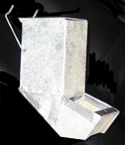
Bin Feeder
Use a ceramic small pet bowl for the first week or so, then switch to a bin feeder.
While they are growing they will eat ALOT. Some feeders have sharp
edges. You can tape these edges
with Duct tape to prevent beak and eye injuries. Make sure the surface is
clean and dry first and the tape is secure so there aren't any loose pieces
the duck can ingest.
• Hot Tip: If
you're not sure it's OK, don't feed it. Be sure your duck is getting a proper diet,
with the right amount of protein. Provide fresh, clean drinking water at all
times, especially during feeding.

Feeding wild ducks
Although Live Ducks is a domestic duck resource website, many people who visit this
website are inclined to feed them in the wild. This information is for you.
If you care about ducks, do not feed them
Enjoy their natural beauty from a distance
and protect their survival by keeping snacks to yourself.
Safe alternatives
Are there any safe foods we can feed the ducks? No, no, and I'll say it again, NO!
Please don't contribute to this problem,
be part of the solution.
What you can do to help
* Read: Feeding Wild Ducks to learn why it's bad
* Stop feeding the ducks
* Tell others (politely) they are harming ducks by feeding them
* Talk to city officials about posting warning signs at your local ponds and lakes
* Encourage schools to teach young children to respect wildlife by not feeding it
* Refer people to Live Ducks website for more information |

|

Drinking and swimming, ducks need water
Ducks need water, clean water. If you don't have a sizeable (preferably filtered) pond,
here's an alternative: Provide fresh drinking water with a reservoir and change
the water at least once daily. Ducks need clean water for swimming and playing.
Water is essential when they are feeding because they use it to clean the vents in
their beak and to wash the food down. They don't have teeth for chewing, so water
helps prevents choking.
Many people we know use hard plastic "kiddie" pools for swimming
because a duck's nails are sharp and
can pop inflatable ones.
Leg injuries are most common when entering or exiting the water, so provide a
sturdy ramp or a series of
shallow steps for your duck to get in and out safely. Be sure to change the water when
it gets cloudy, or after swimming. Your duck needs a safe swimming area, not one
that breeds bacteria, germs, disease, mosquitos...
Chlorine is not harmful to ducks when used as directed. You may want to add a small
amount or use a spa floater in between uses, removing the device while the duck
is in the water. I don't recommend household bleach, use the kind made especially
for pools and spas. Follow directions carefully and keep all chemicals out of
reach of children, ducks and other pets. |
•
Duckling Notes: Without the protective oils produced by the Mother, or
feathers with barbicels that provide a waterproof barrier,
a duckling's down soaks up water like a sponge. They will
tire quickly and drown.
Once they are fully feathered, about
30-45 days after birth, they are safe to be in water without their mother.
Always be sure they can get in and out of the water safely on their own. Never leave
ducklings unattended near water sources they can't stand up in. Be sure their
drinking water supply is
the shallow reservoir type (found in pet stores) otherwise they will try to swim and poop
in it and if it's too deep they can drown.
Clean your duckling's water supply at least twice daily.
Never leave ducklings without drinking water. Ducks are messy
drinkers. Use a shallow food storage container under the waterer to capture
alot of the spillage. |
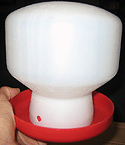
Excellent Waterer |
| • Hot Tip:
On a hot day, our ducks and ducklings love splashing in a running hose (let the
hot water flow out first or it will burn them). |

|

Shelter is very important to a domestic duck
Your pet duck needs shelter - a place to hide from predatory
animals, a quiet retreat from other pets, and a place to escape from the
elements - wind, rain, cold, and sun. The shelter should be large enough
for the duck to fully expand and flap his wings, and move around freely. Cramped,
commercially manufactured shelters designed to house ducks until
slaughter are not suitable for your pet duck.
Pet ducks should never
be caged in small enclosures once they are full grown.
If you can't allow your duck to roam your entire yard,
give them an area of their own that is clean, safe from predators, and
accessable for daily maintenance and feeding.
Some people build their own, like this gorgeous enclosure submitted by Laura Montgomery. She found most of the building materials at a building supply and took extra care to insure her ducks safty and comfort by using sand to cover most of the bottom, special pads to help keep water from puddling, steps to get in and out of the pool, and an interior shelter to keep the ducks feeling safe and dry during bad weather and wind. Cementing fence posts into the ground with keeps them from becoming a potentially life threatening hazard to your pets and to you during severe weather.
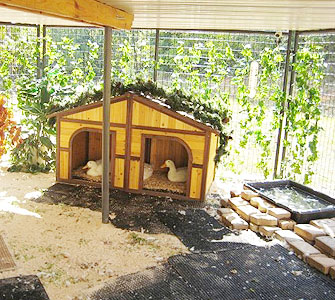
Shelter with steps to access water, rain-proof roof, dug down
deep on the sides to prevent predators from digging in.
Some people use a dog kennel with a
smaller, cozy shelter inside for nightime. A penned area for daytime with a shelter
available for sleeping or privacy is fine. Your individual
situation and climate will determine what's best. If you must confine your duck,
never use litter or wood chips that could present a choking hazard or result in
potentially fatal health problems when ingested.
Newspaper will work in a pinch for an adult duck, not recommended long-term.
Hay or straw is safest, be sure to replace bedding daily. In just a
few days mold forms, causing a deadly environment for ducks. Mold is hazardous to other
animals and humans.
Avoid wire cages without covering all areas exposed to your duck's feet.
Bare wire is painful to feet and can cause injury.
See my duckling's Xrays to see what
happened in a wire cage without enough covering. The vet bill was $395.00 and my duckling
was put through pain and suffering needlessly.
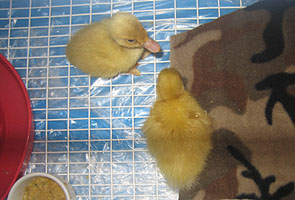
Good material (fleece), but not enough floor coverage
Anywhere ducks walk or rest must be covered
Spaces that are too wide on the sides can trap heads,
causing strangulation and injury to wings. If you must use a wire cage, get the kind with
vinyl coating, and small 1/2" openings at the bottom. Do not use without a covering.
Any old, soft towels, or baby receiving blankets, fleece can be changed
twice a day and machine washed. A piece of pond liner will work. Avoid newspaper for
ducklings, it can cause splay leg.
|

YOUR DUCK SHELTER NEEDS
Space
• To move freely /flap wings
Heat Source (Cold climates)
• Ceramic or light bulb
(up to 100 watts)
• Out of reach to avoid injury
• Room to move away if too hot
Sun Shade (Hot climates)
• Umbrella, lean-to...
Protection from Predators
• Cats, dogs, other pets, wildlife
(cage completely if in danger)
• Vermin, bugs, ants, spiders
Regular Cleaning
• At least once daily
 |
|
While ducks cannot be potty trained, some people have
effectively diapered their ducks using baggies and rubber bands.
(See Quack Q & A for more information.) Diapering
makes keeping ducks indoors (or in a mud room or service porch) easier when
the weather gets particularly harsh. Start while they're young for best results.
Supervision at all times is smart in case the duck gets the baggie in its mouth.



"Winterizing" Domestic Ducks
In winter months, be sure there is adequate heat as well as ventilation.
Depending on your climate, use a 75-100 watt standard light bulb, infrared
or ceramic bulb. Make sure you keep the heat source higher than they can reach,
away from water exposure, and in a corner where the duck can move away from it if it
becomes too hot. Adjust the light as needed and keep away from flammable materials.
You can build a shelter with insulated walls, waterproof roof, windproof walls, and a
rubber flapped entrance/exit (large doggie door). This will allow your duck to
have shelter from extreme conditions and be able to roam outdoors. You can also bring
your duck into a garage, service porch or basement at night, making sure there is
adequate food, water and warmth.
The breed of duck and number you have may be a factor in
severe cold tolerance, some domestics can handle ice and snow longer than others. Ducks
will huddle together to keep warm in extreme conditions.
Sudden outdoor temperature changes of just a few degrees can cause pneumonia and
other problems, so be sure you have a warm, dry, clean shelter for your duck. Damp food,
bedding and soil produce harmful infections and highly toxic mold spores.
This is your pet, so play it safe.
People have written in with good things to say about using Rubbermaid sheds as
night shelters. With some holes drilled for ventilation, this makes an ideal winter
home. In extreme conditions, have a plan ready and be prepared to provide a
porch, clean and dry garage corner, basement or other area sheltered from cold
winter drafts.
To keep small ponds from freezing, try using an aerator or pump to keep water
moving. There are several de-icing devices available to keep ponds from
freezing over in cold weather including heated buckets and heated watering fountains. Just be careful not to use anything that your duck could become injured by or drown in, such as a 5 gallon bucket.
Try
Pond Solutions
for product information on pond heaters. According
to them, de-icers
thaw a small portion of the frozen surface to allow toxic gasses to escape and oxygen
to enter. A pond heater may be more what you need. They have them too.
While I do not recommend the use of ANY electric heaters I'm interested in tent heaters that run on propane. If they are safe for humans,
they might be just what you're looking for to keep their living quarters comfortable in
extreme cold snaps.
TENT HEATER CLOSEUP
Outdoor Spaces
has a helpful article to introduce you the technology.
Here's a couple retailers who carry them now:
• Zodi Outback Gear
• Safety Central (Coleman Brand)
Shop around because features and prices vary widely.
|
There is some debate on whether ducks need warmth during extreme conditions. I'm going on what many people have written to me, and my own experience. Most say their ducks will gravitate towards a heat source when it's present and others have said their ducks "teeth" actually chatter when it's very cold. As long as there is NO CHANCE of fire or injury to the duck, I say make your duck comfortable, just check in on them often and make sure they can't get to the heat source or wires.
Also, remember while wild ducks are sometimes seen in very cold environments, they have been conditioned to live in extremes for many many years. Domestic ducks have lived with humans on farms for hundreds of years and most of their wild instincts and characteristics have been bred out. Their physiology has changed as well.
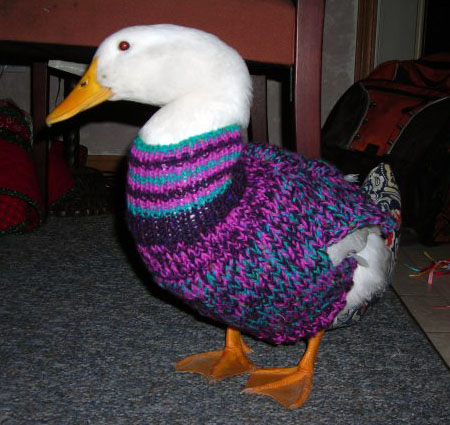
Christine Glenn's duck Fritz enjoys her toasty new sweater!
This was a first for me, I've seen duck diapers, harnesses, wheelchairs and this is the first duck sweater I've ever seen! Make sure your ducks have an adequate amount of time during each day (or several times a day) to preen, wash and stretch their wings, and while your ducks are outdoors, it's probably not a good idea to constrict their wings at all. Be very careful not to injure your ducks wings when putting on or taking off the sweater. Also, wash the sweater in gentle detergent every few days or as it gets dirty. Avoid using dryer sheets which are saturated with chemicals and a potential irritant. Use dryer balls or hang dry.
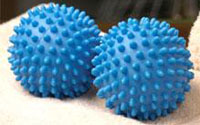
Dryer Balls are safer than dryer sheets
I love the idea of using a sweater when you are transporting your duck in the car for any reason. With some creativity, you can make your own sweater from a square of fleece and velcro and without buttons or snaps that a duck could injest.

In the summer months, ducks generally need less weather resistant shelter,
but they do need an escape from the hot sun and summer electrical storms. We've heard of ducks getting sunstroke when over-exposed.
Always keep fresh drinking water, shade and shelter from wind
available at all times. Never use pesticides to keep bugs down. Search for bird friendly options such as Liquid Fence, which I have not personally used so I'm not sure how well it works. The manufacturer claims it is safe for birds and pets. |
•
Duckling Notes: When ducklings
first hatch, and for the first couple of weeks, they are perfectly fine in a large
cardboard box with a newspaper lined bottom, and a layer of old clean towels
for traction (to prevent
a condition called "splay-leg", sometimes called "sprattle leg").
Provide a heat source, such as a 60-100 watt light bulb, higher than they can
reach, and in a corner so they can adjust their position under it as their body
temperature changes. One or two ducklings will have trouble keeping warm without Mom,
so this is important. If you have several babies, they will huddle together and stay warmer.
As they get older they will need less heat and when fully feathered in about 4-6 weeks
you can remove
the heat source. Once they outgrow their box, put them in a large pen or cage with
small openings between the bars that
they can't get their head or wings caught in. Never leave ducklings outdoors
in cold weather or allow them to remain wet. For 3-4 weeks they need steady warmth 24 hours
a day.
• Hot Tip:
Extra-large plastic storage
boxes make great "day shelters" and transporters for ducklings, and are easily
cleaned. If you plan to use the lid, make sure to cut several air holes for adequate ventilation. |
 |

Behavior and Personality
Domestic duck behavior is somewhat different than wild ducks. In the wild, ducks
are free to choose mates, swim, fly eat and live freely without being confined.
Pet ducks may not have these same freedoms, but they have learned to adapt to
a confined life over hundreds of years of being bred in captivity, relying
solely on humans for their primary care. The quality of your pet duck's life depends
largely on how committed you are to his care and well being.
The
most common behavior problem I hear about is
pinching, chasing and overly aggressive behavior. Males
sometimes display "playful" aggression around 6 months or later. If it
is not discouraged from the beginning it can get out of control.
There is no tried and true solution I'm aware of to curb the behavior other than
providing a mate and restricting your pet to a safe, good-sized area of his own,
always making sure he gets alot of your family's daily attention. If you are more
of a "hands on" duck owner, be sure to get your duck used to being picked up,
gently held, hugged and petted. While a little nip
may be adorable when they are young, it can escalate
into hard pinching and painful bruising when they get older.
Remember, a duck is NOT a good pet for a child unless a parent can provide
100% supervision.
Some people have reported that patience, persistance and
consistancy are the keys to reducing unwanted displays of aggressive behavior.
It may take your duck a year or more to realize you are not a threat, but in fact
his loyal caregiver and loving companion. Unfortunately some ducks
will never change and will always be more difficult to bond with. The good news is
that we do hear of success stories from people who were willing to take the
time and go the distance for their pet.
A few people have written to Live Ducks and said that when the duck pinches,
gently grab their beak - being very careful not to harm their eyes or twist their
neck. Try tapping your fingernail on their beak while sternly saying "NO!".
One woman suggests holding their beak closed while saying "No!" firmly and
not letting go until they calm down. She says she had success with slow
learners by gently
(I repeat gently!) shaking their beak while saying "no!" Sometime just the word
"no!" is enoough for some ducks to straighten up. Be very careful
not to injure your duck while training, never cover their air source and
and walk away if you start to lose your patience. |
• Hot Tip:
Pecking may be cute when he's a duckling, but it
can become a real problem as they get older and it does more damage.
Discouraging bad behavior early on by saying "no!" with a sharp, stern voice when he
pecks while continuing to gently hold and pet him, avoiding contact with his beak.
Hand feeding and daily quiet time in close contact with your duck is helpful in building trust. Over time, most ducks begin to trust that you are friend, not foe. There will be less need for him to use aggression to get your attention.

It's Playtime!
Playtime activities are a great way to get closer to your duck and develop a strong, lasting bond. Schedule some time each day to relax and enjoy your pet.
Some ducks love playing with toys. Others don't care for them. My first duck Trouble had a remote
control jetskier that we'd put in his pond and he'd chase after it and capsize the thing. Mischiefon the other hand was absolutely terrified of it.
Some ducks like floating objects or land based toys like a stuffed animal or ball.
They like pecking at things, so some cat "batting" toys may be appropriate as long as there isn't catnip or scents embedded.
Make sure any toy you provide is child-safe or pet-safe with no small
parts they can injest or choke on. We all know about the danger of plastic baggies.
Ducks are often terrified of anything new in their environment. Introduce toys slowly and allow them to familiarize themselves with the new object. Often, if you leave the duck alone with it long enough, they'll be curious enough to see what this new thing is all about.
Best bets: Balls for rolling, mirrors that are unbreakable or small enough not to shatter easily, stuffed animals - again, toddler-safe ones are your best bet to avoid accidental ingestion of eyes or other loose objects. Remove any hanging tags or paper labels. |

|

Introducing pets to your duck
If you have an existing pet,
you will have a serious problem if the pet considers
your duck a food source, rather than an adorable new friend.
We do not recommend ducks as pets for people with large dogs, cats, or in areas
where neighborhood pets or predatory animals can access your duck.
However there are exceptions to the rule.
People who have the most success are committed to the health
and well-being of all their pets.
Domestic ducks cannot fly away from predators like wild
ducks. They have been bred in captivity, they do not have the instincts or anatomy
to protect themselves like their wild counterparts. Supervise them and
introduce them to other pets with extreme care.
Even if
you have had a duck/dog, duck/cat or other duck/pet combination and have had no problems
in the past, any pet can be unpredictable. The instinct to capture and kill
can surface at any time, even after years of peaceful coexistence. |
| • Duckling Notes: Not a good idea
to introduce other pets at this time, the duckling or you could be injured.
Keep them fully caged if exposed to other animals. If you fel confident that
an introduction is safe, hold the duckling firmly and be prepared to move quickly
and defend yourself if
the other animal attacks. |
| • Hot Tip: In
captivity (as well as in the wild), male ducks, including Dad, often
kill their young for territorial reasons or if the food supply seems threatened.
Keep ducklings protected from adult males until fully grown, and allow them to be
with or near Mom or you'll have her to contend with! |

|

A healthy duck is a happy duck
The first order of business is to find a veterinarian that treats ducks.
Do it now. Do not wait until you have a problem, chances are you will,
and it may take some searching since most "cat and dog" vets do not treat
exotics. Get the name of an after hours emergency center so you have a backup when
your primary vet is unavailable.
Be smart by putting aside a special fund to cover unexpected veterinary or emergency care costs. Most vets do not accept payments, they want at least half down before they'll treat your pet and the remainder before releasing him to you.
Ducks are low on the food chain. As a defense mechanism they often mask symptoms of
illness or disease until they can't hide them any longer. By the time
you notice a problem they may have been ill for some time. Many duck illnesses can
be treated succesfully when caught early.
In an emergency wasted time can mean life or death for your pet.



Disease and infection information is now detailed on our Health Care section.
There are links to websites on the bottom of this page that will provide more detailed
information on specific diseases, infections and illness.



General health concerns
• Wing clipping is not necessary for most domestic breeds. All but
two that we know of do not fly, they have been bred in captivity for many years and
are too heavy to fly. Clipping feathers improperly
may cause bleeding, infection and death. If you feel wing clipping is necessary,
have a qualified veterinarian do this.
• Wing injuries happen when fencing has sharp wires sticking out
or due to a variety of preventable causes. Use common sense and give them plenty of
room to move. A condition commonly called "Angel Wing" or "slipped Wing" happens
when the primary feathers grow in abnormally due to feeding protein levels beyond
the recommended amount. Decrease protein levels (see feeding section above) and in
time the wings will return to normal.
• Molting occurs about every six months or so. Generally in the
Spring and Fall, but not as a rule. The ducks get
"scruffy" looking and you'll notice alot more lost feathers in their habitat. As
feathers regrow, wings can be especially tender. Avoid contact with the
wing area during this time.
• Leg injuries occur most often when ducks are entering or
exiting the water. Provide a ramp with good traction or wide, sturdy steps to
get both in and out of water safely. Wire cages are also a common source
of injury. Cover all exposed wire flooring (see shelter for details).
Bumble foot has symptoms of swelling, redness
and possible infection. Get a vet's advise when symptoms first appear. Also,
some illnesses such as Botulism, Pasteurella and poisoning can cause weakness
and appear to be a leg problem.
Ducks often raise one leg and sleep while standing. This is normal behavior.
Injuries to toes and feet, limping or sores can
be signs of a serious problem and should be treated by a qualified veterinarian.
• Poisoning can be prevented by making sure your duck
is not exposed to pesticides, chemicals, lead-based paint, coins, screws,
nails, lead shot, fishing weights, or any small objects that can be ingested.
Lead, zinc and copper are the most common toxic items found in ducks suffering
from poisoning. The zinc in one penny is enough to kill a duck. There
are treatments that a vet can administer that will counteract the poison
when caught early. They include medicines given by injection and laxatives.
A blood screen is the most common diagnostic tool used. Do not try "home remedies", seek
expert help.
Beware of certain foods that can be toxic or cause painful conditions such as
seeds, nuts, human "junk" food, chocolate, etc. If you are not
sure about it, avoid it.
• Bare spots resembling mange on a female's neck or head, and
around the eyes is often caused by rough mating. We've seen this condition in both
wild and domestic ducks. There is a crust that forms on the female's
head from the male's mucous that is secreted from the male's mouth
during mating. If clean water is unavailable for regular bathing, you
will need to rinse the head or in severe cases wash with "no more tears" baby
shampoo to prevent eye infection and other problems.
Ducks prefer to mate on water, and some of the injuries and infection
associated with rough mating
can be minimized by providing clean swimming water.
• Beak spotting or discolorations should be discussed with your
vet, we are not sure of the cause or treatment. Our vet is unsure of any health concerns
connected with beak spotting. We suspect it is fungal, but no published treatment is
available to our knowledge. "Warts" or bumps on the beak are generally
caused by pecking or digging, but there can be other causes. In some cases, this
results in a blister-like bump that needs to be drained and treated with
antibacterial ointment. Digging, or rubbing the beak on sharp or hard surfaces
can cause abrasions. Remove the hazard and consult a vet if bleeding is present.
• Respiratory problems, such as coughing, sneezing, wheezing and
what appears to be choking or gagging, should be discussed with your vet ASAP. A
rapid air temperature change of just a few degrees can cause pneumonia.
Ducklings can develop colds or other problems when exposed to water
or cool air too long - keep them warm and dry following swimming until they are mature.
If your duck or duckling has "cold-like" symptoms, get to a vet for treatment right away.
There are several conditions that display coughing and wheezing symptoms, ranging from
food being caught in the esophagus to life-threatening conditions that are often
treatable, but only when caught early. Delaying treatment can mean the difference
between life and death - and also save hundreds of dollars in vet bills.
• A Clean habitat, is critical to your duck's health and well-being.
Sweep or hose droppings daily, keep swimming water, drinking water and food bins
clean and pest-free. Supply clean, dry bedding daily for adults, twice daily for ducklings.
Duck droppings make an excellent fertilizer for plants and vegetables.
Never use household cleaners or
chemicals that can poison your duck. Avoid using pesticides around pond borders or
anywhere your duck might roam. Keep all injurious or hazardous materials and their
containers out of reach of your duck.
• Pay attention to your ducks. They need your love and attention, and
will become depressed and lonely and can become ill when neglected. Some ducks like
playing with stuffed animals, mirrors, balls and floating toys - and you'll find they
enjoy the attention they get from you most. |
| Use common sense, there is alot of
great information available on duck care. Look at
other resources including other websites and books. Talk to your vet and do
what is best for your situation. The fun you have with your duck and the
love returned is well worth the extra effort it takes to raise a unique and
special pet. |
• Hot Tip Find
a licensed exotic pet veterinarian who treats ducks before an emergency arises.


Help for Very Special Ducks
After hearing about several challenged ducks, I've added this Special Needs section to help anyone with similar problems. While there are a number of reasons your duck may have problems walking including recovery from injury and congenital defects, some very resourceful people in the duck community came up with a great way to assist their challenged pets. They used materials you can find at most any hardware or building supply. The original design for this Duckmobile came from Lemon the Duck, the inspiration for the charming book by the same name.
While I do not have instructions available for the design, on my Facebook Live Ducks Group, you may be able to locate someone in the group who has built one and ask them how they did it.
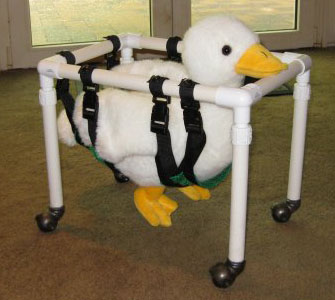
Amazing Duckmobile with Harness
This design is inspired by Lemon the Duck's adaptive gear and was submitted by Laura Montgomery who constructed it for her own duck. Note that we fully realize the model for the design is a stuffed animal - we may be a little nuts, but we're not that crazy!
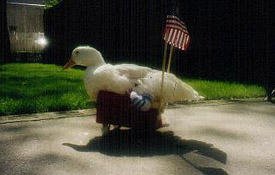
Another Duck Mobile Design
A little hard to see, but this is effectively a wheelchair designed by Sharon Demeola and her husband Ritchie. They rescued and named this badly injured little angel Sebastian. While Sebastian is in heaven today, the design of the cart is also a good one. There is a spot to attach a leash and it comes with wheels so the duck can get around with a little human help. Note the side rails so the duck can stay upright much easier. Balance can be a little tricky when the legs aren't working, but there's nothing a duck can't overcome with a little help!
|

|

Causes, symptoms and treatments for a
variety of duck diseases:
|

|

|